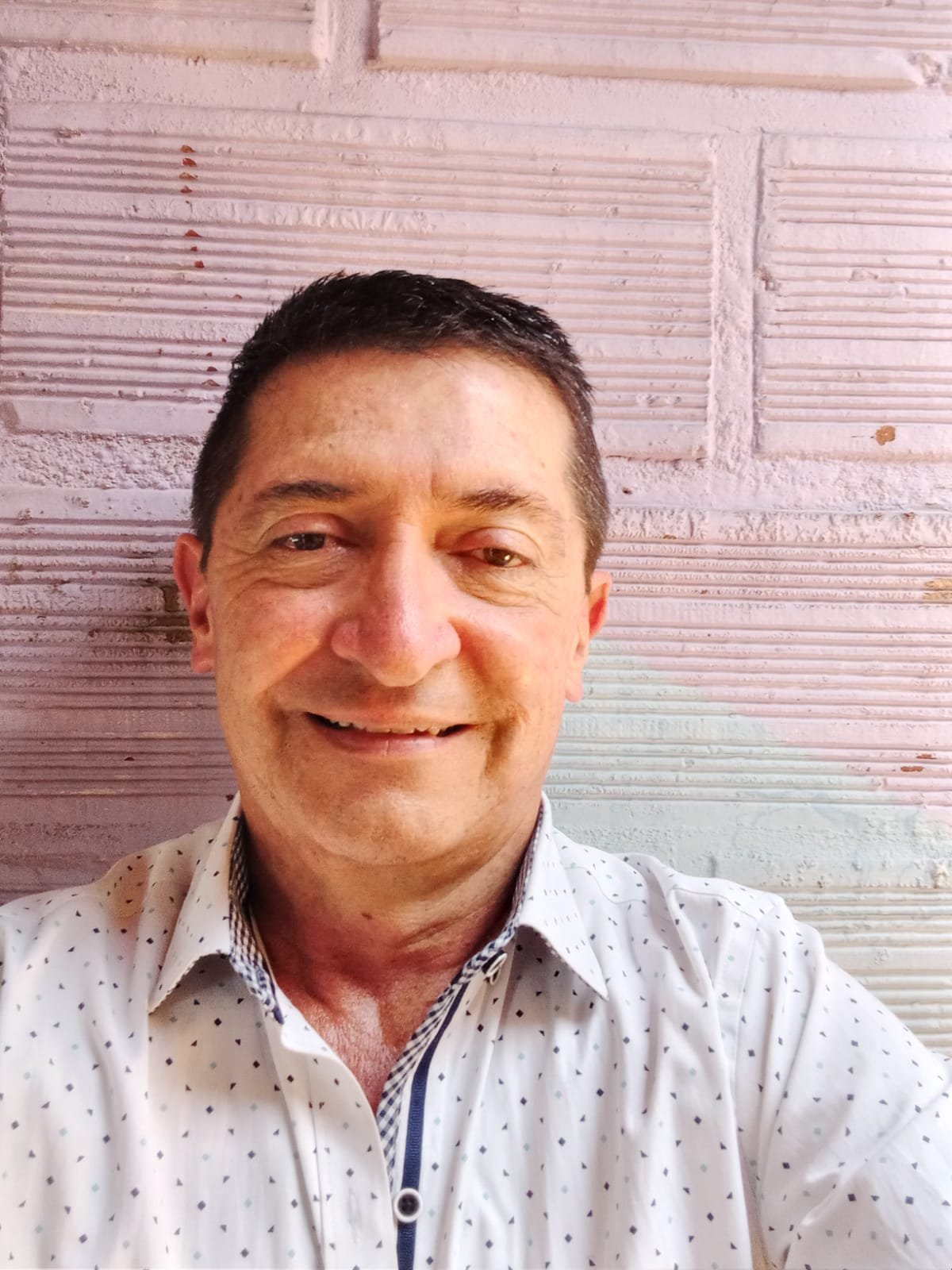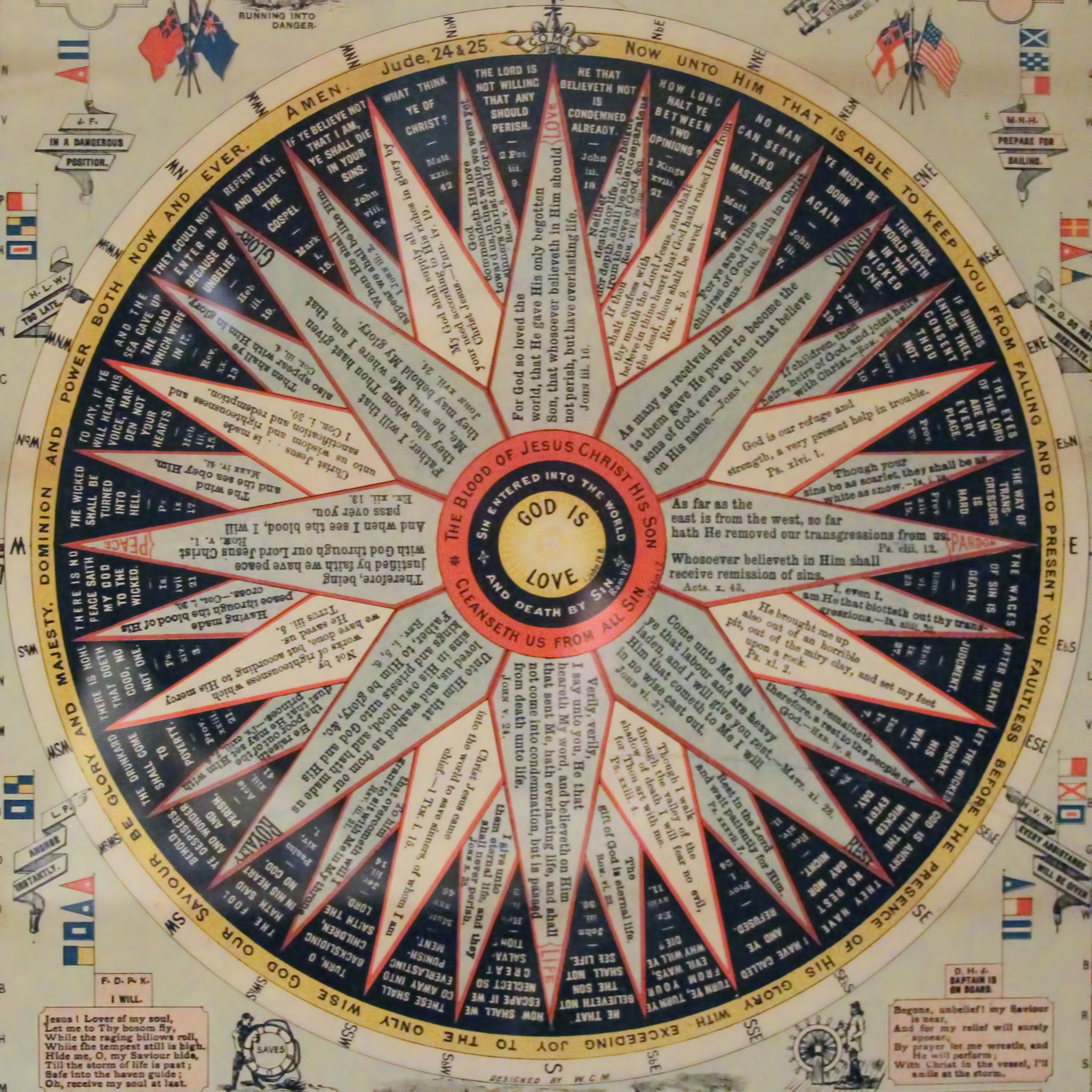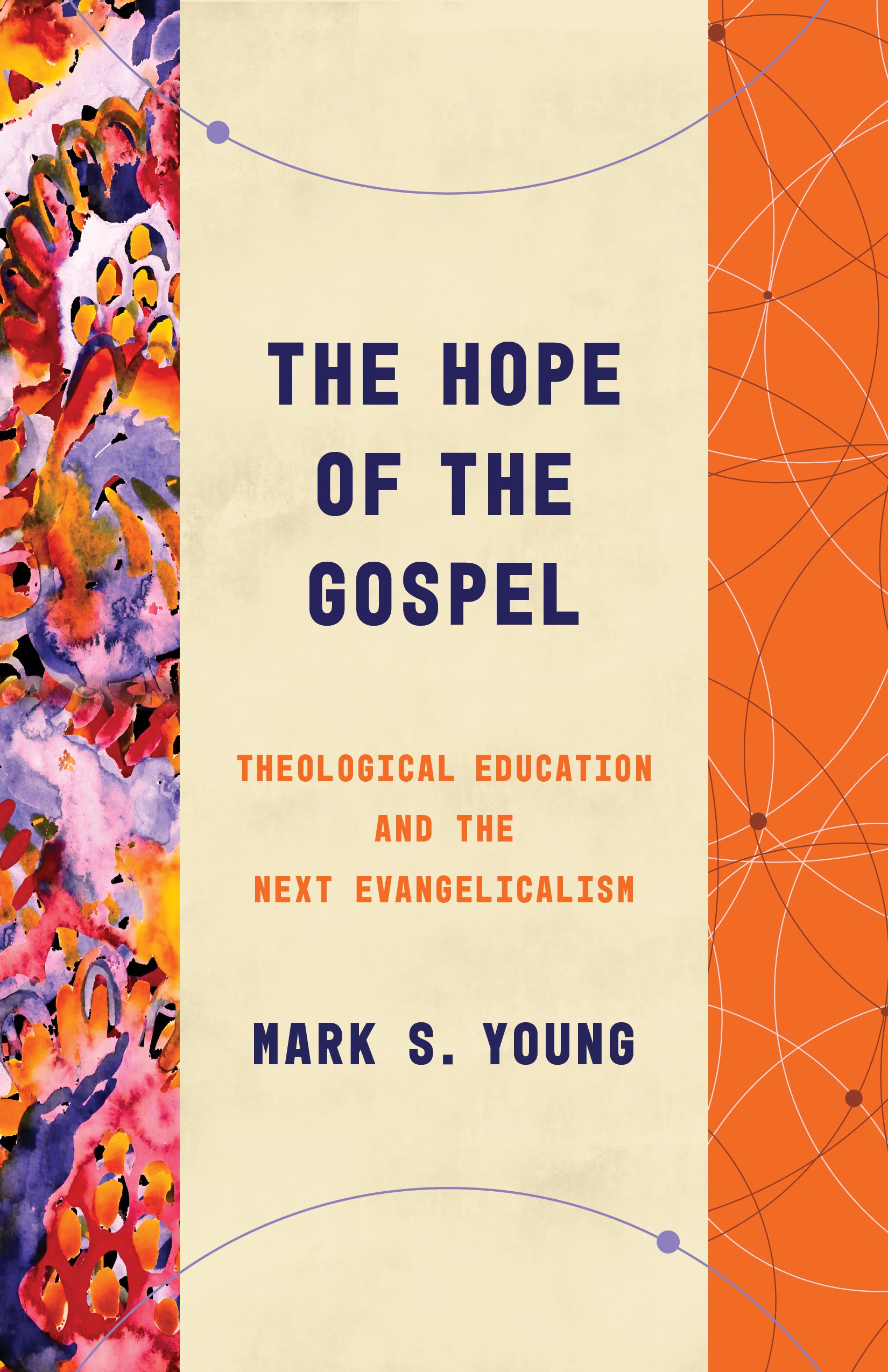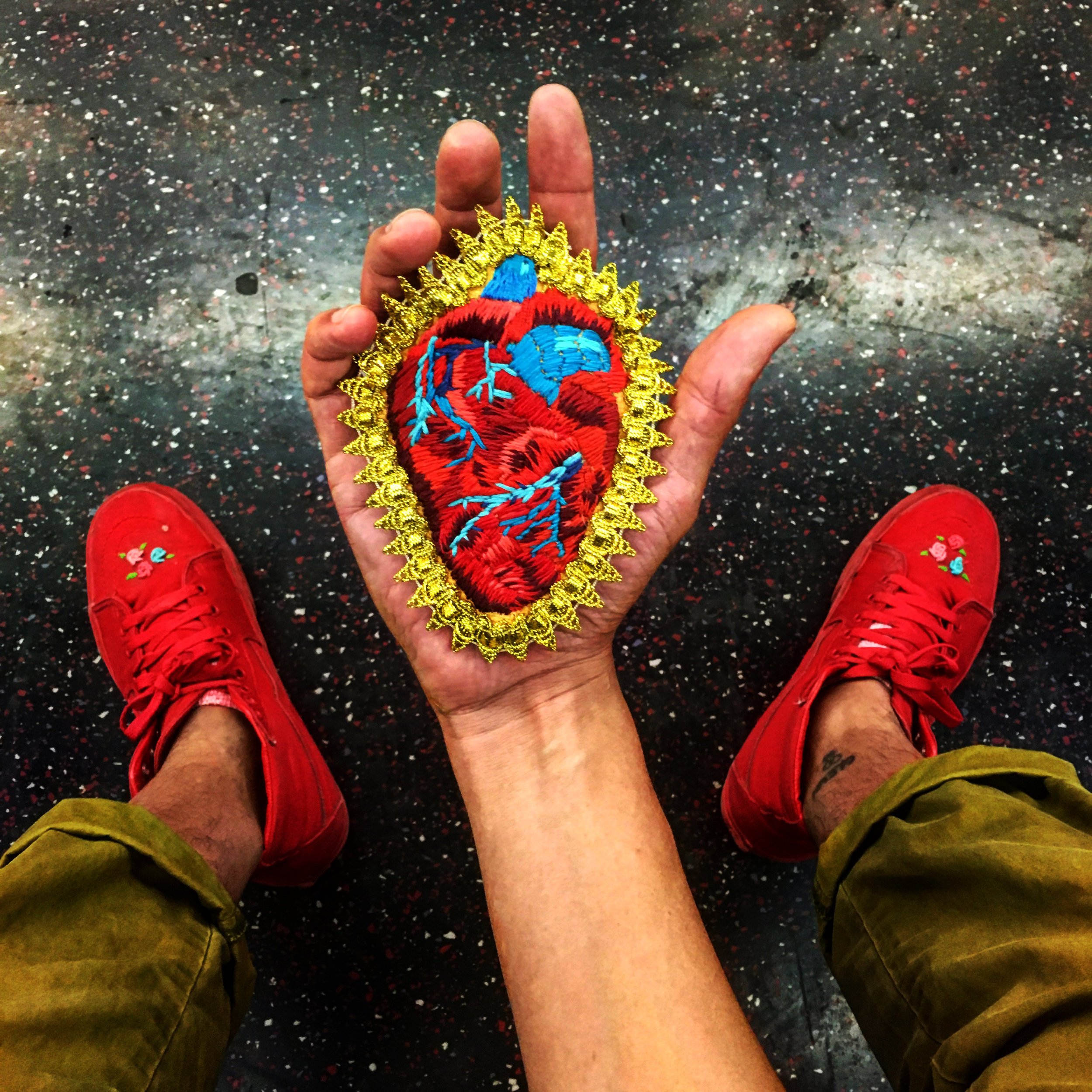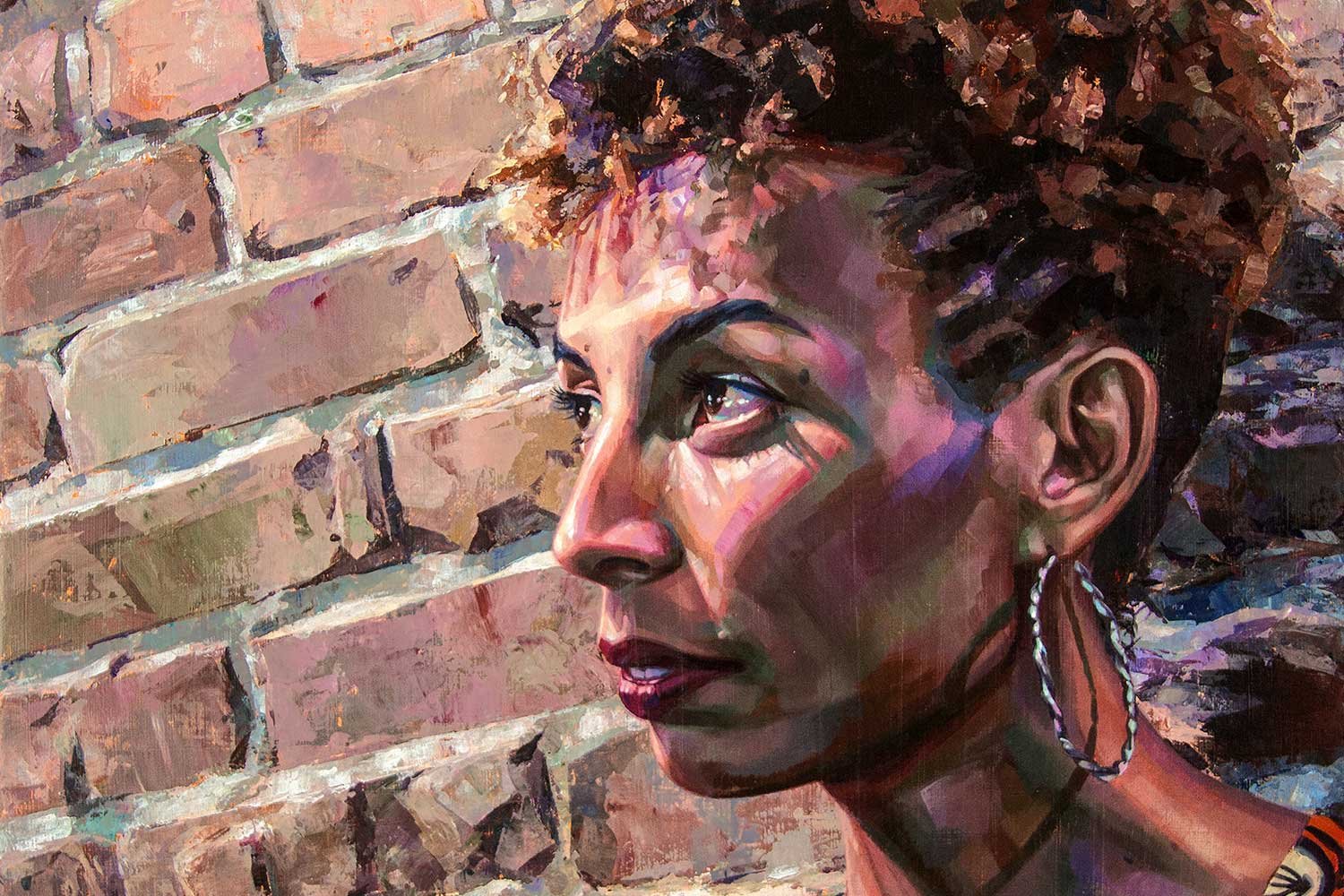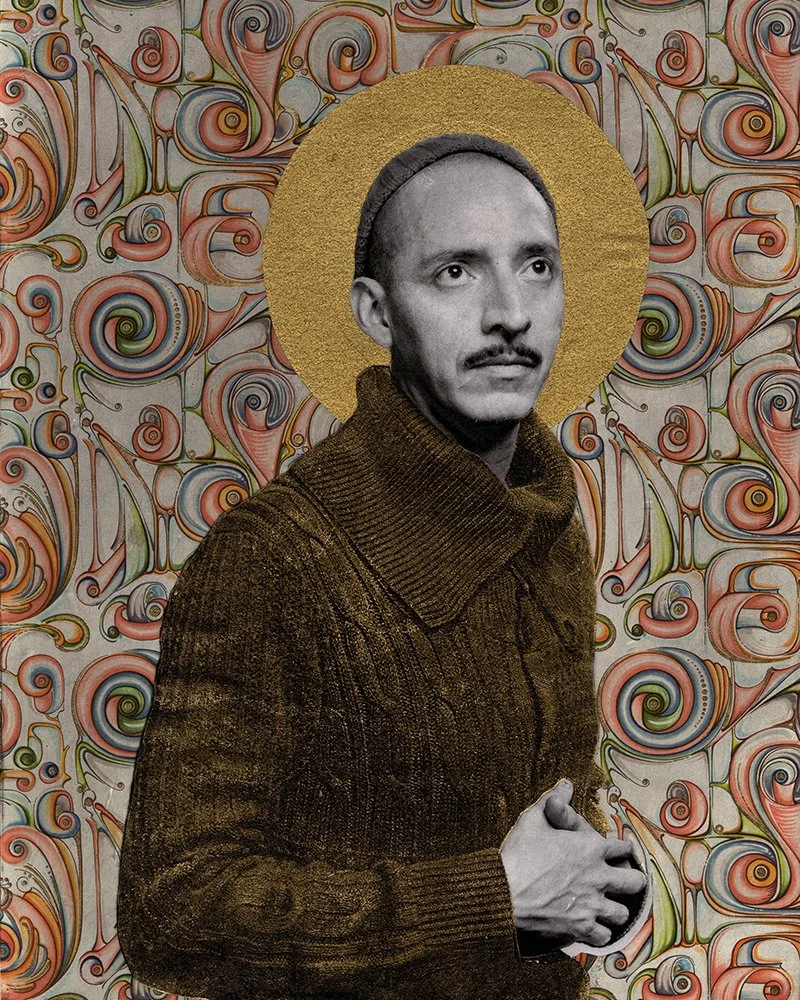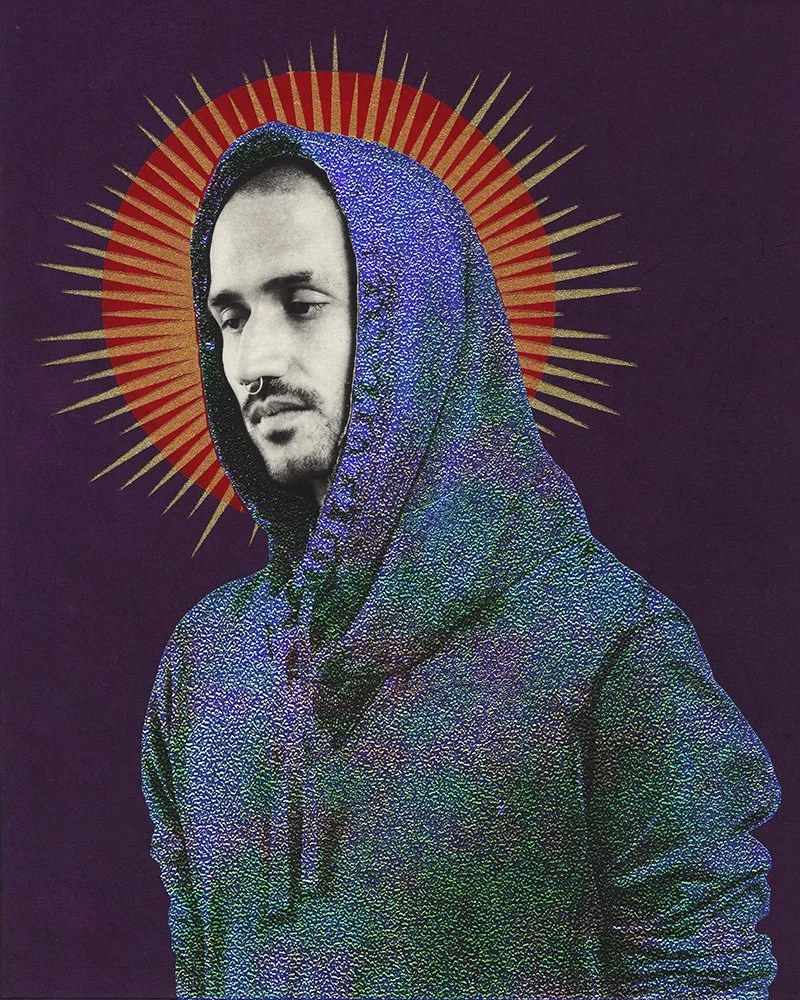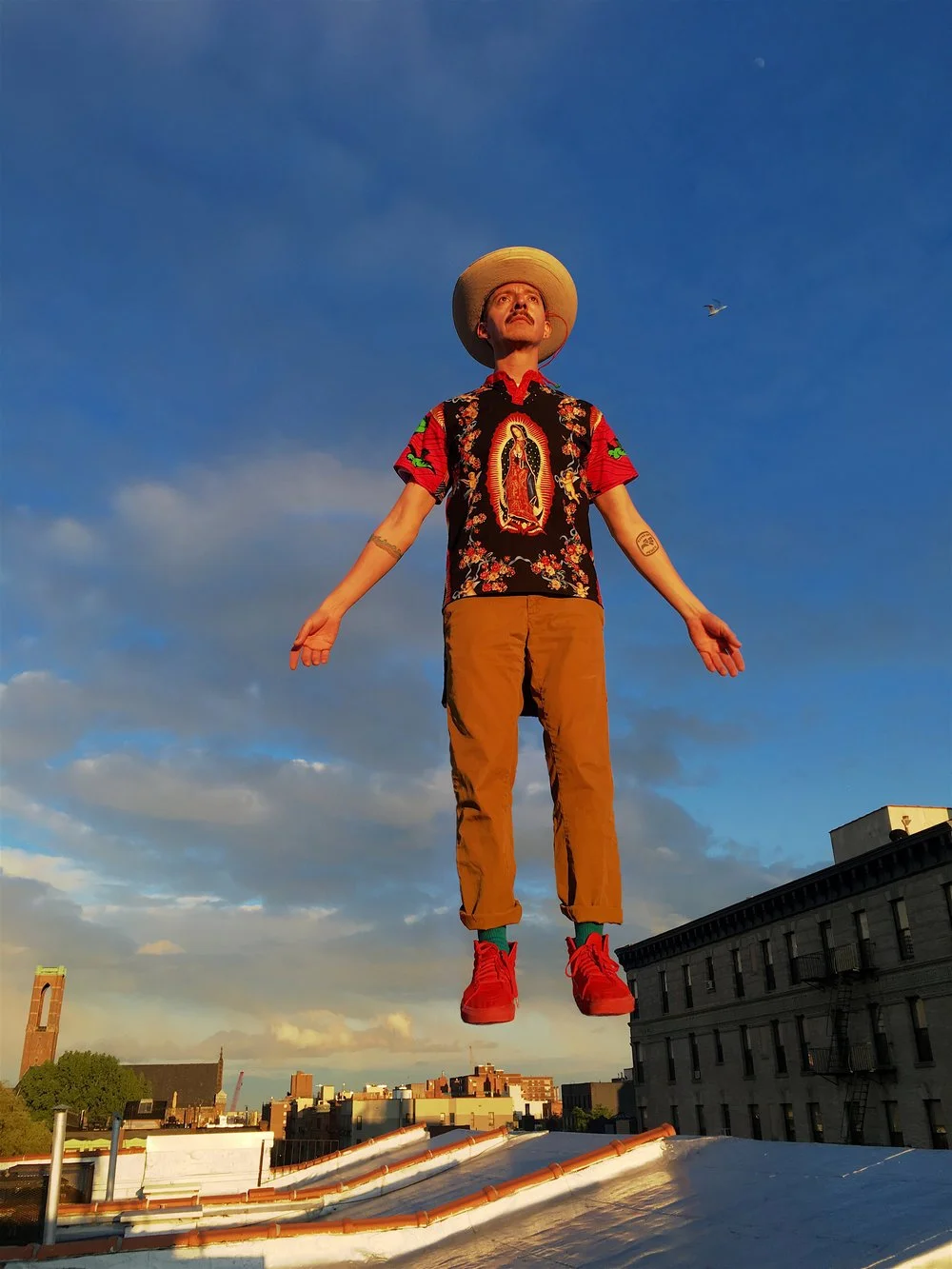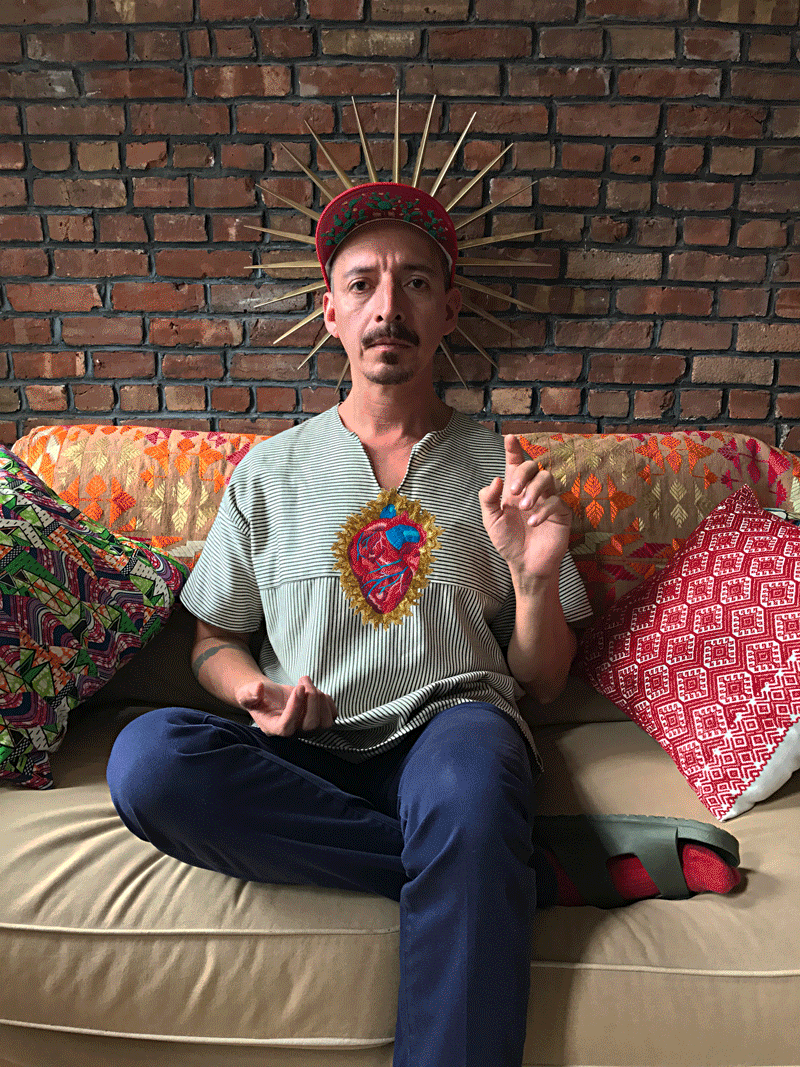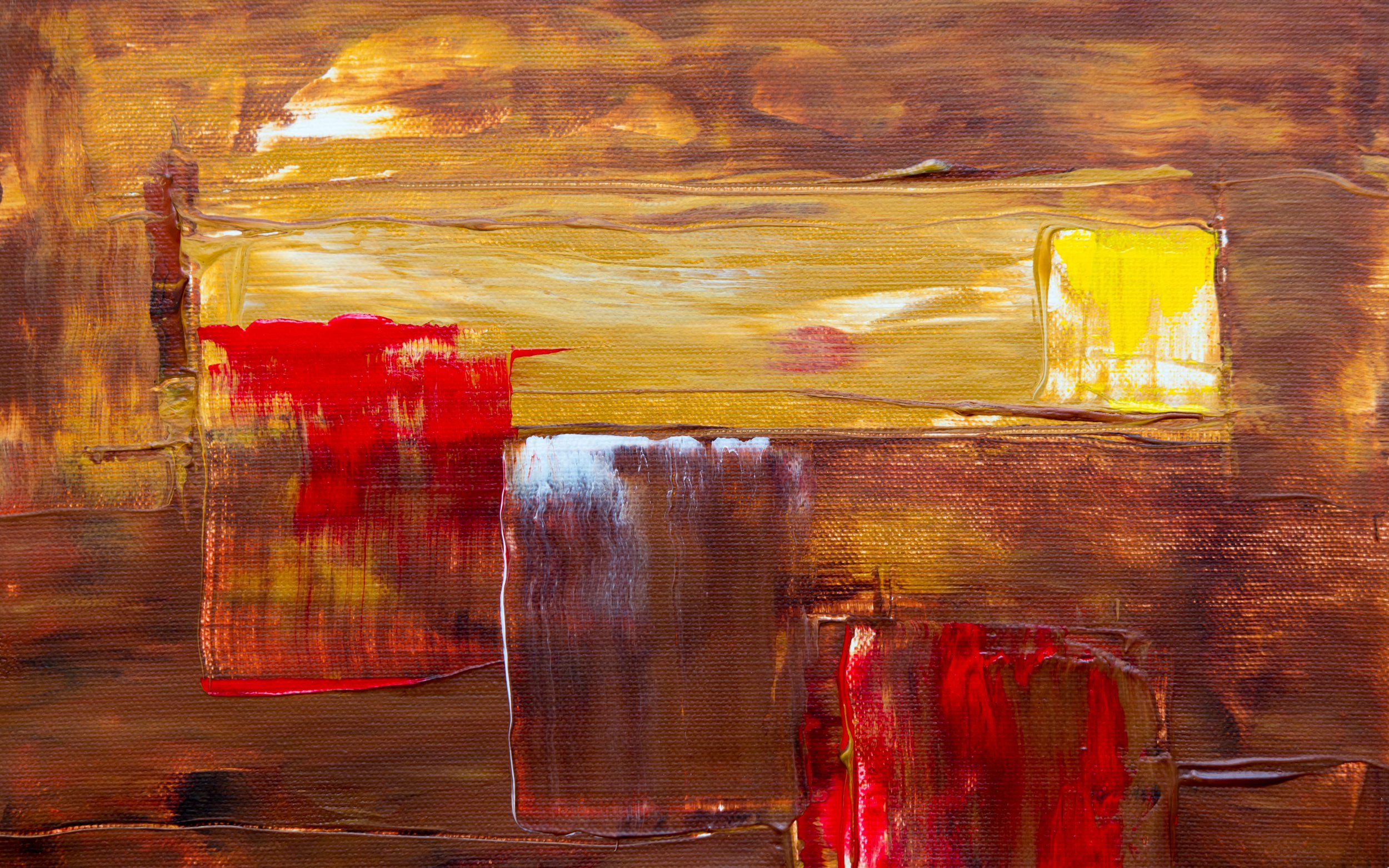Revisión de pura vida
“El Profe” Yonar Brenes Masís entrevista a Hernán Ramírez, al P. Federico Carrasquilla y a Benedito de Queiroz en Medellín, Colombia
“El Profe” Yonar Brenes Masís entrevista a Hernán Ramírez, al P. Federico Carrasquilla y a Benedito de Queiroz en Medellín, Colombia
NOTA EDITORIAL
Yonar Brenes Masís es profesor docente en el Ministerio de Educación Pública de Costa Rica y presentador del podcast El show de Yonar BM. En 2023, asistió–junto con su esposa Francini y su padre Héctor–al Encuentro Continental Fraternidad Secular San Carlos de Foucauld América en Medellín, Colombia como delegado de Las Fraternidades de jóvenes en Costa Rica.
Durante el encuentro, Yonar entrevistó a tres participantes cuyas vidas lo inspiran: Benedito de Queiroz (Profesor de Historia de la Red Pública Estatal en Brasil), Hernán Ramírez (Coordinador Fraternidad Secular Carlos de Foucauld de Colombia) y el Padre Federico Carrasquilla (“Apóstol de los Pobres”). Yonar y su equipo grabaron estas pláticas en el Centro de Formación Los Pomos (adscrito a la Arquidiócesis de Medellín) en diciembre de 2023.
NOTA DEL PROFE
Mi trabajo como profesor es en el área social, histórica y geográfica como docente de Estudios Sociales, pero lo importante es que este trabajo se desenvuelve con población joven y adulta. De ahí es que, por más de ocho años, he trabajado con ellos y aprendido a escuchar, sus historias, sus necesidades y sus experiencias. Este proceso me ha generado la inquietud de poder entrevistar a personas como Hernán, Federico y Benedito para transmitir un pequeño extracto de sus vidas, vidas entregadas en la lucha social–pero ante todo, llevando esperanza y la palabra de Dios hecha ejemplo para entregarla a la gente.
–Yonar BM, enero 2024
NOTA DE ENTREVISTADO
Mi ruta de vida aparece como una cadena de decisiones que son ilógicas, o contraproducentes, o aún que se pudieran calificar como “fracasadas.” De lo contrario, mi ruta de vida se entiende si se mira desde una perspectiva de fe, de persona que me transformó en creyente, que creo en Jesús de Nazaret, que—desde lo pequeño, desde lo local, desde lo privado y en un movimiento de apertura hacia lo público, hacia otras esferas más amplias de la sociedad—va construyendo.
—Hernán Ramírez, enero 2024
Una vida con el desplazado en Colombia
Hernán Ramírez
En esta conversación, he tenido el placer de conversar con Hernán Ramírez (Medellín, Colombia), un hombre que vivió la época más difícil de la historia reciente de Colombia., Además, sigue trabajando por los más desfavorecidos de la actualidad, una labor para aplaudir.
Temas tratados: inicios de Hernán; viviendo en Medellín; problemas sociales en Colombia; grupos disidentes en Colombia
Historia de vida
Padre Federico Carrasquilla
En esta oportunidad, tuve la dicha de conocer y conversar con el Padre Federico Carrasquilla (Medellín, Colombia), un hombre que me ha impactado grandemente por su sencillez y don de amor. Debo agradecer a mi amigo Hernán Ramírez– también de la ciudad de Medellín–por la oportunidad de conocer a "Fede," como lo conocen de cariño. Decir todos los logros de Padre Fede se queda corto—para míi lo más importante es su amor por la gente.
Una vida en el Amazonas
Benedito de Queiroz
En esta conversación, tuve el placer de platicar con con Benedito de Queiroz (Macapá, Brasil), un hombre entregado a su tierra. Su amor por la naturaleza es completo. Les invito a hacer conciencia de la importancia de cada día proteger y defender nuestro medio ambiente. Todos podemos dar un aporte a mejorar el presente y el futuro.
The Hope of the Gospel
Dr. M. Daniel Carroll Rodas talks to Dr. Mark S. Young about his book on theological education and the next evangelicalism
Dr. M. Daniel Carroll Rodas talks to Dr. Mark S. Young about his book on theological education and the next evangelicalism
Detail from “The Gospel Compass for Sailors of All Nations” (ca. 1880), designed by W.C. Miles. Source: Time and Tide Museum of Great Yarmouth Life, Great Yarmouth, Norfolk, England, UK. Photo: Leo Reynolds
Old Testament professor Dr. M. Daniel Carroll Rodas talks to Denver Seminary president Dr. Mark S. Young about his book The Hope of the Gospel: Theological Education and the Next Evangelicalism (Wm. B. Eerdmans, 2022), which argues for returning evangelicalism to its core commitments.
“We read the Bible too simplistically,” Dr. Young tells Dr. Carroll. “We interpret the Bible too arrogantly, and we apply the Bible too selectively.” Some of us, for instance, treat the Bible like “a handbook with tips for, you know, better living: how to parent your children; how to use your money; how to overcome whatever X,Y,Z. So a lot of evangelical preaching lands on these practical tips of how to live a better life. And, indeed, the Bible is full of wisdom, but it's not just a handbook for happy living.” Dr. Young adds that readers latch on to the idea that the text is “inerrant,” so “we interpret it very arrogantly and say this is the only way this passage can be understood. And then, when I say we apply it selectively—if we're honest with ourselves—we have a canon within the canon. We all choose passages that we say are going to shape the way we do things.”
Along with the book, this conversation is part of the Theological Education between the Times (TEBT) series, an initiative out of HTI member school Emory University Candler School of Theology that "gathers diverse groups of people for critical, theological conversations about the meanings and purposes of theological education. The project begins with a recognition that theological education is between the times, on the way. And it works in the confidence that we do not walk this road alone."
“Mark Young writes as thoughtfully as an evangelical and as insightfully as the president of a leading American seminary. Evangelical theological educators should read this book because it will remind them of the gifts that have distinguished this evangelical movement and point them to the generative work that needs to be undertaken to extend those gifts into the future. Others should read this book because it gives needed clarity to the identity confusion evangelicalism is experiencing and provides valuable insight into the work of evangelical theological schools.”
— Daniel O. Aleshire
Executive Director, Association of Theological Schools (1998-2017)
St. Everyday (Part II): Mais Viva!
Dr. Xochitl Alvizo and students ‘heart’ Gabriel García Román’s visit to their Queer Theory class
Dr. Xochitl Alvizo and students ‘heart’ Gabriel García Román’s visit to their Queer Theory class
When I was first introduced to the work of Gabriel García Román’s work, specifically the Queer Icons portrait series, I noted the immediate connection between his art and the subjects I teach in my Queer Studies and Religious Studies classrooms at California State University, Northridge.
The intersection of religious studies/theology and queer theory is always a little surprising to my students. For them, issues of gender, sex, and sexuality are very fixed ideas in relation to religion, and they do not expect much new information on the topic – much less positive or constructive perspectives. As I see it, though, part of my job in the classroom is precisely to complexify and bring out the many dimensions inherent to the subject and to move students from their assumed, inherited, and usually uncritical perspectives to a more nuanced and complex understanding of religion and sex, gender, and sexuality. I therefore have my students engage work that scholars, religious leaders, and activists are producing in these areas, often born out of social-justice commitments.
Left to right: Rev. Freda (n.d.) and Fei Hernandez (2018). From the Queer Icons series by Gabriel García Román.
The impact of Gabriel’s Queer Icons on my students’ imagination is very often paradigm-shifting and liberative, especially as they become equipped with new theorical lenses from which to continue viewing and engaging with this subject and in light of the usual (negative and judgmental) messages and news reports they encounter in the media about religion and LGBTQ lives. As some students observed:
I definitely have this sense of urgency to live, to resist death not only out on the streets but sometimes within the home…It's inspiring to see stories like Fei Hernandez and Jay Ulanday Barrett, seeing people like me continue to live on today. But how much longer do we have to resist death? (del Rosario)
I learned that the word activist is more than just a word. Activists have faces, are educated, scholars, artists, creators, courageous, speakers, writers, strong as a result of personal experiences that have shaped them...I see Gabriel's work differently now. I see it as a tribute to activists who don't stop, don't hide, and fight a daily battle for the rest of us. (Thompson)
Gabriel introduces the Queer Icons series to the class
(includes a few brave students who were willing to appear on camera)
In my classes, whenever I use art or visual media to spark the discussion, we start with two questions, distinctly engaging with each, one at a time: What do you see? What do you wonder?
I emphasize to the students that they should first only make strict observations, withholding their evaluation, interpretation, or judgment for later, and only name what is observable. Once they’ve done that, they can then raise questions about the art–but only questions that are directly related to what they first observed. This allows students to open themselves up to new insight and to keep from simply jump to their brains’ already embedded associations, interpretations, or judgments—an important task indeed when one is reflecting on the intersection of religion and sex/gender/sexuality.
On the day of Gabriel’s visit to our class, the students followed this two-question process with two of his Queer Icons and shared their impressions of his art right in his presence. They did a wonderful job and asked him many detailed questions about his process, material, colors, and, especially, his inspiration.
In turn, Gabriel engages with the portrait work of interdisciplinary scholar, artist, and activist Dr. Dora Silva Santana.
Gabriel responds to students of Queer Theory
Dr. Dora Silva Santana, a Black trans feminist scholar from Brazil, is a faculty member at John Jay College, CUNY. She believes that “academia can be a strategic space for critical thinking leading to social transformation.”
I first encountered Santana’s work when researching trans queer of color scholars for my Perspectives in Queer Studies class. And while Santana’s work does not explicitly engage religion, her theoretical lens helps to interrogate religion’s death-dealing approaches to queer living. I specifically use her article “Mais Viva!: Reassembling Transness, Blackness, and Feminism” (Transgender Studies Quarterly, 1 May 2019) to provide a framework with which students can interrogate the negative and death-centered lens through which Queer lives are most often presented in media, art, and, of course, within religious communities. Santana puts forth the concept of “mais viva,” a Brazilian Portuguese term meaning “more alive, alert, savvy.” Santana introduces the expression to capture the “embodied knowledge of black and trans resistance, [as] a kind of critical awareness necessary for building self-love and building community.” Mais viva is a way of living that targeted communities find necessary in the face of ongoing harassment and marginalization.
Herself a trans woman, Santana asks:
“What are the strategies of resistance and care for ourselves and our communities in the face of the haunting and material presence of death? How do we imagine possibilities of livable lives, of freedom, well-being, and transformative change, as we resist death?” (210-11)
Dora, portrait of Dora Silva Santana by Drew Riley. From Gender Portraits, a nonprofit project of the Austin Creative Alliance that advocates for sex and gender minorities through art.
Conducting research with travesti women and activists, and collaborating with black feminists in Brazil, Santana comes to identify the “Afro-diasporic legacy of fugitivity” that is embodied in a community’s “refusal to lose oneself” (210). This fugitivity and refusal to lose oneself, to be mais viva, amid the reality of diaspora, of being in movement and transformation, “make[s] intelligible the embodied...call for action of black and trans people transnationally” (210).
For the purposes of my class, the importance of Santana’s scholarship and Gabriel’s art lies in how their work brings attention to the strategies of resistance that are about queer living, not their dying, a vitality seldom given attention to in the media. As both Gabriel and Santana observe, what dominates in the news about members of the LGBTQ+ community is related to their death or murder – an individual typically being spoken about only as corpse.
Like Santana’s methodology aims to do, Gabriel’s Queer Icons portrait series humanizes the LGBTQ+ community, presenting a collective of individual lives, people he holds up as saints and icons because of their living and of the ways they advocate for and advance their communities. Queer Icons celebrates and sanctifies queer living and their social-justice legacies. Each Queer Icon is a representation of a person mais viva – of their strength and power, their activism, and their refusal to lose themselves. And their vivir is extended through the work they do for their communities.
Gabriel reflects on the intersection of Santana’s work with his own
In the spring of 2021, feeling the need for a change of scenery, Gabriel visited his native state of Zacatecas, Mexico. Even this choice to take a trip, with the aim to “rebuild and re-emerge whole,” Gabriel captures well the spirit that likewise goes into his work – his commitment to fill in a gap he saw in the art work and actively counter-narrate the way queer lives are often negatively reflected. During my interview with Gabriel, I am also struck by how grounded in purpose he is and how integrated his values are in various aspects of his life.
“This is my life's work,” he says. Sometimes I like to visualize myself as a monk in the mountains, just working on something, and this is going to be what I do for the rest of my life, and I will be completely content just doing that.”
I think about academics and the place within us from which our own work flows. For us, too, there is a beauty that comes through when our work emerges from a grounded place: our own values and commitments.
As one student, Duran, puts it: “What shines through the most for me is the pride. [Queer Icons] is a beautiful stance of disruption. It’s an exclamation that I am beautiful here and now.”
The world needs more of this beauty.
Highlights from Student Reflections
del Rosario: I definitely have this sense of urgency to live, to resist death not only out on the streets but sometimes within the home. It's inspiring to see stories like Fei Hernandez and Jay Ulanday Barrett, seeing people like me continue to live on today. But how much longer do we have to resist death?
Cantu: All of the people in Gabriel’s art imagine possibilities…and their existence is resistance. The subjects are resisting by existing, every single one of them, they are either decolonizing or being anti-colonial, and that is the cure.
Villareal: [Regarding the religious motif] I almost immediately noticed the halo-like effect behind everyone's head. I could tell that the artist purposely wanted to show them in a saint-like position because religion is a very important aspect on many people of color's life.
Ueng: I see each and one of their pride to confidently stand in front of a camera being bold and proud of who they are. There is this sense of fierceness that you can see in each person's eyes, the unapologetic look, the look that says "I am not sorry, I am doing this on purpose and living." The reason why portraits are amazing is because we can see a finer detail of a person's face and figure.
Thompson: Initially, I saw Gabriel Garcia Roman's work as an homage to the many queer and trans people who are living their lives openly, at some risk to their safety and the comfort of societal norms. I saw these people as gender-fluid, queer, and unafraid bold warriors leading the cause for queer rights and greater freedoms. I loved the photography and their short but inspiring biographies. After going through Roman's website I spent time digesting the readings…I learned that the word activist is more than just a word. Activists have faces, are educated, scholars, artists, creators, courageous, speakers, writers, strong as a result of personal experiences that have shaped them.
My final read of [Santana’s] first paragraph was much clearer. It was about an experience of seeking out kinship, community, "livable lives," safety, more "freedom" and stability in a hostile cis-heteronormative environment where Trans people are tolerated at best, but constantly on high alert and having to live on their nerves and instincts to survive. I see Gabriel's work differently now. I see it as a tribute to activists who don't stop, don't hide, and fight a daily battle for the rest of us.
His work has inspired me to do more, to push harder and to seja mais viva!
Duran: What shines through the most for me is the pride. This collection is a beautiful stance of disruption. It’s an exclamation that I am beautiful here and now; by my standard of beauty and embrace for every shape, face, color, background, sexuality and experiences we all have as individuals. As Dora Santana stated we need to seek understanding of each other's unique life experiences, so we can truly discuss allegiance with each and truly advocate for genuine change.
Martin: Once I took this reality in [Santana’s method from the article], I could so clearly see the strength in the eyes of each of Gabriel's subjects. I found myself even more interested in their lives and their stories than I ever was before. Each of the people illustrated have their own story like Selen's and they deserve to be heard. Being able to revisit Gabriel's work really just gave me a much deeper appreciation for all that he was doing.
Cho: I really enjoyed the reading in connection to the photos…I can feel the energy of the people standing in the photos considering I might have had similar experiences of societal judgment. I also liked how the paintings gave off a saint-inspired aesthetic around these queers to give them a look of a healing higher power…I was mesmerized with the way they were all illustrated. At first, they appeared like saints, but after careful inspection, they were not depictions of traditional saints, but definitely on the spectrum of divine creatures…These illustrations alone demanded my attention for minutes at a time.
Gonzalez: After reading, Mais Viva! by Dora Silva Santana and focusing on the A luta é nossa! Viva a vida! (It Is Our Fight! Live Life!): Fugitivity as Refusal section, I felt it was really powerful for this passage to demonstrate despite being discriminated against and constantly met with challenges of violence or hate, you still must move forward…This theme of “live life!” embodies motifs of will-power, courage, and resilience. There is something not just incredibly beautiful about that, but also alluring in the sense of wanting that exact same attitude and mindset for life. After revisiting Gabriel Garcia Roman’s works, I got that same sense of rebellion, anarchy, and war for spiritual freedom from each [icon]…In the revisit, each individual’s beauty and humanity stood out to me more. Each life has a beautiful story to tell, and as I continue to look through each person’s story, I feel even more grateful that they shared such an emotionally-moving artistic profile of themselves. Additionally, I began to appreciate the hints of religious style in the art depictions even more.
Embroidered corazón patch by Gabriel García Román
View Gabriel García Román’s work at http://www.gabrielgarciaroman.com/.
St. Everyday (Part I): Queer Icons
Dr. Xochitl Alvizo profiles artist Gabriel García Román, creator of the QTPOC portrait series
Dr. Xochitl Alvizo profiles artist Gabriel García Román, creator of the QTPOC portrait series
Let me introduce you to Gabriel García Román, an artist of many trades and the creator of Queer Icons, a portrait series featuring queer Latinx artists, activists, and community organizers. Through his series, Gabriel visually represents people of the QTPOC community as the saints that they are: folks who live in ways that bring life to others. Each portrait is unique and fashioned in the style of Catholic icons, with typical motifs of Catholic religious art – halos, metallic tones, elaborate frames, and carefully positioned hands. The process of making the portraits into icons is slow and requires much patience—a process Gabriel describes as a meditative experience. Through this careful process and final outcome, he honors the work of each saint, honors their being, and presents the poet/artist/activist in a beautiful, empowered posture.
His is a very intentional labor of love.
Queer Icons portraits by Gabriel García Román; photogravure with chine-colle. Clockwise from top left: Castro, Bayani & Candy, 2019; Mitchyll, 2014; Gabriela, 2018; and Carlos & Fernando, 2016.
Gabriel intended for Queer Icons to fill a gap in how the QTPOC community has (or has not) been represented in the art world and other media. This absence of representation became a personal and social concern for him, both in terms of his own identity as part of the QTPOC community and more broadly as well. Among those in his mind were queer young people isolated in small towns who might not have or see themselves reflected in people with whom they can identify or look up to—an experience he had firsthand. Gabriel came to his vocation, and to art school, later in life (late thirties). And while there, he noted that he never saw himself or his community “represented in any way—[not] in any of the art spaces, galleries.”
This lack of QTPOC community representation in both virtual and physical art spaces became the inspiration for the Queer Icon series, which aims to change the narrative. For Gabriel, not getting to have imagery “that looks like them” means not having art as a source that “gives them power.” And wanting to give people his art as a source of power is also part of why the people Gabriel highlights as icons are not high-profile folks but “everyday saints” doing their work on the ground.
“I don't want this to be a popularity contest,” he says, “where I want the big names who are in the media. No, I want the local person who started a kitchen for trans women in Harlem…Or, you know, somebody that's not necessarily getting all the media attention.”
In filling the representation gap, Gabriel intentionally uses the power of art to both humanize the QTPOC community in an unjust world and to empower those it marginalizes. He thus works painstakingly to capture the human dignity and the story of each person he photographs.
Gabriel on the making of Queer Icons
Gabriel speaks of his work as his practice. The meditation and intentionality that he puts into his practice imbues the icons with spirit. When he gets to witness people appreciating his art, he recognizes that they are not only receiving the spirit he has put into the work but also the power of the saints themselves. His intention for this encounter to, in turn, help draw out the viewer’s own power– a power that inspires Gabriel even further. Seeing somebody's eyes light up when they are before a Queer Icon motivates him to then do “the next one, and the next one…” Gabriel acknowledges the exponential growth of the project: “It started off as something very personal to me…[but] at this point, [it] has become a lot bigger, and it’s no longer my project – now it's my community’s project.” Because of such scale, the burden of “perfection” has not been an obstacle to his work. He embraces the practice, along with all the “mistakes” that may be involved, since they are part of what brings the work to completion– a concept many of us in the academy often have a difficult time embracing.
Gabriel on the practice of craft
In hearing Gabriel speak about his work—at once so personal to him but which he also holds with openness and easily gifts back to his community of inspiration—I’m struck by his groundedness. He embodies the very power he wants his Icons to convey to the world, and he is very clear about the community of accountability to whom he feels responsible. I covet the ease he seems to have with himself, and the focus and conviction with which he approaches his art. And yet a distinct “lightness,” both in his very being and in his art, also comes through.
His self-portraits (not part of the Queer Icon series) often show him floating or elevated as if ascending to the heavens. His groundedness is also his lightness, a connection he acknowledges. As he moved into his vocation as an artist, as he embraced his art as his practiced, and as he became increasingly comfortable with himself and the truth of who he is – neither from “here” nor from “there”—Gabriel came to know and embrace his own worth, and that, he says,
“is very similar to an ascension to the heavens…Knowing yourself, getting to know yourself, is definitely almost like going to paradise, because nothing that somebody could say can knock you down, because you know who you are, you know your worth.”
Knowing one’s worth and recognizing the worthiness of others, especially those who we dehumanize in society – personally, systemically, structurally – is very much what Gabriel’s Queer Icon series is about. I see how the work comes from his own sense of vocation, intention, and commitment to his community.
I connect this devotion with the ways that the Hispanic Theological Initiative (HTI) calls us to be true to our own sense of self and encourages us to bring that to our writing, even as we acknowledge all the complications that surround us. Just as Gabriel attunes to his “subjects,” we must similarly be attuned to ourselves and to one another so that we can keep on this road together, in the in-between spaces that are oftentimes our home as Latinx folks in the academy. We must stay grounded in ourselves and in community, so that we can also elevate.
Gabriel on the beauty of community, reflection, and struggle
View Gabriel García Román’s work at http://www.gabrielgarciaroman.com/.
COMING SOON…
St. Everyday (Part II): Mais Viva!
Dr. Xochitl Alvizo sums up Gabriel García Román’s visit to her Queer Theory class at California State University, Northridge and her students’ engagement with his work, along with the scholarship of Black trans feminist scholar Dr. Dora Silva Santana of John Jay College, CUNY.
Photo and animation: Gabriel García Román
Descolonizando la educación teológica latinoamericana
Stephen DiTrolio Coakley habla con el Dr. Nicolás Panotto acerca de su próximo libro sobre ‘religión, educación y teología con acento poscolonial’
Stephen DiTrolio Coakley habla con el Dr. Nicolás Panotto acerca de su próximo libro sobre ‘religión, educación y teología con acento poscolonial’
En este episodio de OP Talks, Stephen DiTrolio Coakley habla con el teólogo y profesor Dr. Nicolás Panotto sobre su próximo libro Decolonizing Theological Knowledge in Latin America: Religion, Education and Theology with a Postcolonial Accent [Descolonizando el conocimiento teológico en América Latina: religión, educación y teología con acento poscolonial](Editorial JuanUno1, 2021). El Dr. Panotto se desempeña como director de Otros Cruces, una organización dedicada a inspirar el diálogo, la democracia y los derechos humanos a través del intercambio de conocimientos entre la fe y la realidad, las comunidades religiosas y las organizaciones de la sociedad civil, y entre los caminos espirituales y los actores políticos.
LEA MÁS
Panotto, Nicolás. “De otros saberes y conocimientos-otros. Una revisión (crítica) de la descolonización epistémica en los saberes/sabidurías teológicos.” Teología Práctica Latinoamericana, Vol. 1, No. 2, julio/diciembre 2021.
Decolonizing Latin American Theological Education
Stephen DiTrolio Coakley talks to Dr. Nicolás Panotto about his forthcoming book on ‘religion, education, and theology with a postcolonial accent’
Stephen DiTrolio Coakley talks to Dr. Nicolás Panotto about his forthcoming book on ‘religion, education, and theology with a postcolonial accent’
In this episode of OP Talks, Stephen DiTrolio Coakley talks to theologian and professor Dr. Nicolás Panotto about his forthcoming book Decolonizing Theological Knowledge in Latin America: Religion, Education and Theology with a Postcolonial Accent (Editorial JuanUno1, 2021). Dr. Panotto serves as director of Otros Cruces, an organization dedicated to inspiring dialogue, democracy and human rights through knowledge exchanges between faith and reality, religious communities and civil-society organizations, and between spiritual paths and political actors.
READ MORE
Panotto, Nicolás. “De-colonizing theological education: towards an ecology of theological knowledges in Latin America.” Presentated at the Reformation-Education-Transformation Twin International Consultation, Halle, Germany, 13 May 2016.
After Whiteness
Dr. Teresa Delgado talks to Dr. Willie James Jennings about education in belonging and forming people who form communion
Dr. Teresa Delgado talks to Dr. Willie James Jennings about education in belonging and forming people who form communion
Dr. Teresa Delgado and Rev. Dr. Willie James Jennings discuss his most recent book, After Whiteness: An Education in Belonging (Eerdmans, 2020), the inaugural volume of the groundbreaking Theological Education between the Times book series. As the publisher notes, Rev. Dr. Jennings draws on "the insights gained from his extensive experience in theological education, most notably as the dean of a major university's divinity school—where he remains the only African American to have ever served in that role." In order to “tell the truth from deep down inside of it,” says Rev. Dr. Jennings, “I couldn't get to it just by standard academic writing. I can only get to it by drawing on all the sides of what it means to talk and write about life, but also all the sides of me.” In the book, these “sides” include vignettes, poetry, short stories, and analysis. “What I try to do is to bring people in through the back door,” he says. “I was an academic dean. I learned all the secrets. Yes, I cannot tell you the secrets, but I can tell you what they mean.”
This episode of OP Talks is part of the Theological Education between the Times (TEBT) series, an initiative out of HTI member school Emory University Candler School of Theology that "gathers diverse groups of people for critical, theological conversations about the meanings and purposes of theological education. The project begins with a recognition that theological education is between the times, on the way. And it works in the confidence that we do not walk this road alone."
In the tradition of bell hooks and Paulo Freire, Jennings’s insightful indictment of the church and university will be an ideal choice for group discussion…When the academy is not a home, but your skin, paying attention requires everything. A fearlessly candid diagnosis of the failures of the theological academy—its soul-killing cultivation of the self-sufficient man builder—Jennings’s poetic truth-telling nevertheless refuses cynicism’s surrender.
— Andrea C. White
Union Theological Seminary in the City of New York
Attempt Great Things for God
Rev. Dr. Sammy Alfaro and Dr. Chloe T. Sun celebrate theological education in diaspora
Rev. Dr. Sammy Alfaro and Dr. Chloe T. Sun celebrate theological education in diaspora
Rev. Dr. Sammy Alfaro talks to Dr. Chloe T. Sun about her book Attempt Great Things for God: Theological Education in Diaspora (Eerdmans, 2020). Part of the TEBT book series, the work was inspired by Dr. Sun’s experience of being born in China and raised in Hong Kong, before coming to the United States to attend college and where she would become a Christian. “In this process of finding my vocation,” she says, “I struggled with the question of who am I, really—in terms of my identity, my ethnic bicultural identity, and my spiritual identity—and so it took me a while to figure that out.” Dr. Sun encourages others to “find that identity in God's Kingdom and to embrace it and to share it with those who have struggles about who they are in this journey of theological education.”
This episode of OP Talks is part of the Theological Education between the Times (TEBT) series, an initiative out of HTI member school Emory University Candler School of Theology that "gathers diverse groups of people for critical, theological conversations about the meanings and purposes of theological education. The project begins with a recognition that theological education is between the times, on the way. And it works in the confidence that we do not walk this road alone."
“This book fills a gap in our knowledge of theological education in the diaspora by showcasing the story of Logos Evangelical Seminary. Chloe Sun challenges the narrative of decline of theological education in America and helps us reimagine the future of theological training with vision and hope. I highly recommend this insightful text.”
— Kwok Pui-lan
Candler School of Theology at Emory University
Theological Education between the Times
Dr. Antonio Eduardo Alonso, Lucila Crena, and Rev. Dr. Ted A. Smith introduce a project out of HTI member school Emory University Candler School of Theology
Dr. Antonio Eduardo Alonso, Lucila Crena, and Rev. Dr. Ted A. Smith introduce a project out of HTI member school Emory University Candler School of Theology
Theological Education between the Times (TEBT) is an initiative out of HTI member school Emory University Candler School of Theology that "gathers diverse groups of people for critical, theological conversations about the meanings and purposes of theological education. The project begins with a recognition that theological education is between the times, on the way. And it works in the confidence that we do not walk this road alone."
HTI Open Plaza’s TEBT series features several conversations among the scholars involved in the project, as well as excerpts of related publications. In this introductory OP Talks episode, TEBT Advisory Board member Dr. Antonio Eduardo Alonso (Assistant Professor of Theology and Culture and Director of Catholic Studies) talks to his Candler School colleagues and fellow TEBT leaders—Managing Director Lucila Crena (Instructor of Theology, Ethics, and Culture) and Director Rev. Dr. Ted A. Smith (Professor of Preaching and Ethics)—about the project’s origins. At meetings that spurred conversations and a multi-genre series of books, they gathered to explore a diverse world of thoughts about theological education.
“We met seven times over a couple of years and wrote books together, worshipped together, shared a lot of big moves in our lives together, and now the books are coming out,” says Rev. Dr. Smith. “It’s not really just kind of rolling out the books, it's letting the books be part of a conversation that's now expanding again, sparking new conversations that are deeply contextual where they are. I hope we can start, like, hundreds of little wildfires of theological reflection on theological education, and let the books be part of that, and let them be interconnected.”
Theological Imagination in Education
César ‘CJ’ Baldelomar, LL.M., J.D. and his mentor Dr. Hosffman Ospino survey possibilities
César ‘CJ’ Baldelomar, LL.M., J.D. and his mentor Dr. Hosffman Ospino survey possibilities
Salvation Mountain, a man-made visual environment created by Leonard Knight in the California Desert. Photo: April Morales
Catholic theologian Dr. Hosffman Ospino focuses on the dialogue between theology and culture, and the impact of this interchange upon Catholic theological education, catechesis, and ministry. In this episode of OP Talks, Dr. Ospino engages in conversation with his mentee César ‘CJ’ Baldelomar, whose “Toward a Critical Theological Imagination” examines the role of imagination in knowledge production and the need for a critical, decolonial engagement with theology. Published on Open Plaza throughout a summer of Black Lives Matter protests, Baldelomar's three-part series of essays “urgently calls for critical theology theorists in hopes of liberating imaginations to envision what never was…If this call is not taken seriously, then perhaps the only remaining solution is indeed to press the restart button on the entire theological—and by extension, academic—enterprise.”





